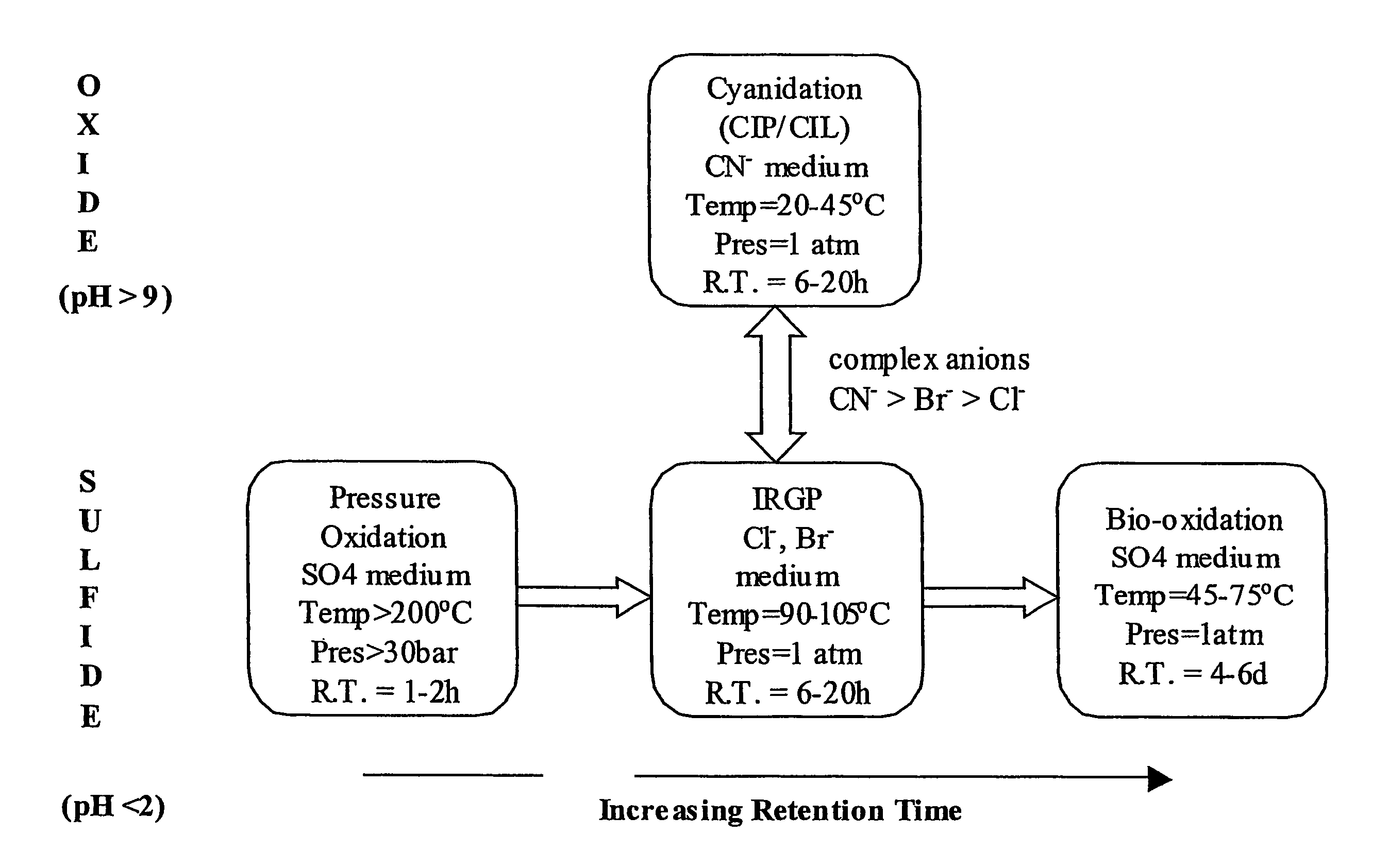Recovering metals from sulfidic materials
a metal and sulfide technology, applied in the field of recovery of metals, can solve the problems of difficult processing of contaminants, complex ore treatment, and contamination of deposits, and achieve the effects of high oxidation potential (eh), low energy consumption, and convenient recovery of precious metals
- Summary
- Abstract
- Description
- Claims
- Application Information
AI Technical Summary
Benefits of technology
Problems solved by technology
Method used
Image
Examples
example 1
[0144]As a preliminary evaluation, the gold extraction from a first concentrate was conducted in three different steps: arseno-pyrite leach, a pyrite leach 1 and a pyrite leach 2. The following laboratory test reports describe the procedure and results of these three steps. CON1 01 refers to an arseno-pyrite leach and pyrite oxidation 1, and CON1 02 refers to a pyrite oxidation 2. The first concentrate was milled to P80=30μ and subjected to an As leach followed by pyrite oxidation.
Aim
[0145]The aim was to apply the IRGP to a single refractory Au concentrate. An ore sample was provided to a metallurgical lab for milling and concentration.
Procedure
[0146]This experiment was conducted in two parts and was carried out in a 7.5 L titanium insulated tank. The first part, the As leach, used a conventional mixer. The second part, oxidation of the pyrite, used a flat blade turbine and sparger.
Part 1: As Leach
[0147]In a 7.5 L titanium reactor fitted with a “propeller” agitator, 3.5 L of neutral...
example 2
[0153]An additional pyrite oxidation of the concentrate residue from Example 1 was conducted.
Aim
[0154]The analysis of the data and the residue from Example 1 showed that the pyrite oxidation was not completed when the experiment was terminated. This procedure with an improved brine formula attempted to increase Au extraction using oxygen to oxidise the pyrite.
Outcome
[0155]The second pyrite oxidation improved metals extraction as shown in the following table (based on independent analysis):
[0156]
ElementsOxidation 1Oxidation 2As79.6%92.4%Fe72.2%97.1%Au68.7%93.3%
Procedure
[0157]A 7.5 L reactor was equipped with a flat blade turbine agitator and a titanium sparger. 5 liters of brine solution was prepared in the leach tank with 100 gpl NaCl, 250 gpl of CaCl2 and 100 gpl Cu from CuCl2 and pH<0.5 with the addition of concentrated HCl. The solution was heated to 105° C., t=0 sample is taken and the dry cake produced in Example 1. As leach / Pyrite oxidation was introduced into the tank. After ...
example 3
[0163]In this experiment, the gold extraction from a second concentrate was achieved in three consecutive steps: step 1 arseno-pyrite and pyrite leach, step 2 pyrite leach with oxygen, and step 3 pyrite leach with chlorine.
Aim
[0164]Following a scouting experiment on As leach, this procedure aimed to treat the second concentrate in an “all-in-one” process with a CaCl2 250 g / l and Cu 100 g / l brine. The solid loading was set at 200 g / l.
Outcome
[0165]The chlorine oxidation improved Au extraction as shown in the following table (based on external analysis):
[0166]
Au Extraction(cumulative)Air + Oxygen59%Chlorine87%Overall95%
Procedure
[0167]The procedure was carried out in a 7.5 L reactor equipped with a turbine agitator. 5 l of brine was prepared with the following formula: NaCl 100 g / l, CaCl2 250 g / l and Cu 100 g / l and pH was adjusted to <0.5 with the addition of concentrated HCl.
Part 1: Arseno-Pyrite Leach
[0168]With the agitator rpm at 90%, the brine was heated to 90° C. A sample of soluti...
PUM
| Property | Measurement | Unit |
|---|---|---|
| temperature | aaaaa | aaaaa |
| temperature | aaaaa | aaaaa |
| temperatures | aaaaa | aaaaa |
Abstract
Description
Claims
Application Information
 Login to View More
Login to View More - R&D
- Intellectual Property
- Life Sciences
- Materials
- Tech Scout
- Unparalleled Data Quality
- Higher Quality Content
- 60% Fewer Hallucinations
Browse by: Latest US Patents, China's latest patents, Technical Efficacy Thesaurus, Application Domain, Technology Topic, Popular Technical Reports.
© 2025 PatSnap. All rights reserved.Legal|Privacy policy|Modern Slavery Act Transparency Statement|Sitemap|About US| Contact US: help@patsnap.com



